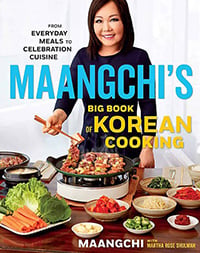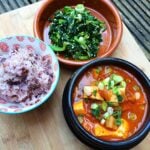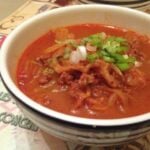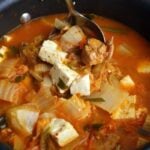I’d like to introduce you to my family’s special kimchi soup recipe today. It’s called kimchiguk in Korean, is very easy to make and it’s a well-balanced “one pot meal” when served with rice. You get the vitamins and minerals from well-fermented kimchi, and protein from pork and tofu. It’s great for the winter: nutritious, warm, and satisfying.
I don’t worry about making any other side dishes when I make kimchiguk. It’s so delicious that I don’t pay attention to anything else, I just keep eating the soup and rice until it’s done. : )
Before there were modern methods of preservation and farming in Korea, we had to prepare food for the long, cold winter when vegetables were hard to come by. Neighbors would get together right before winter starts and prepare huge batches of napa cabbage kimchi together, enough to last all of the families involved for the whole winter. This kind of event was called a kimjang. To make sure the kimchi didn’t freeze over the winter, we stored it in onggi crocks and buried in the ground so the temperature was always above freezing and our families could eat nutritious kimchi all winter.
Of course, nowadays we have vegetables all year long and electric refrigerators, but many Koreans still make winter kimchi in late November because napa cabbage is in season so it’s fresh, delicious and cheap. It’s still the best time to make napa cabbage kimchi.
When I lived in Korea, I usually made winter kimchi in the beginning of December and would eat it until late March of the following year. Like many Koreans living in apartments, I’d keep my onggi on the balcony. When I made kimchiguk, the first thing I did was put on my long red rubber gloves. Then I’d take a stainless steel bowl out to the balcony and get some kimchi. Oh, I’ll never forget the feeling of pressing down on the top of the kimchi in the onggi after taking some out!
You’ll never get tired of this soup. Make this soup and you’ll soon realize why Koreans make such a huge batch of kimchi at the kimjang: we can make hundreds of different delicious dishes with it.

Ingredients (for 2-3 servings)
- 2 cups of chopped kimchi
- ½ pound of pork shoulder (or pork belly), cut into bite sized pieces
- 2 Tablespoons of hot pepper paste
- 1 teaspoon of sugar
- 5 cups of water
- 2 stalks of green onions, chopped
- 1 package of tofu (14 ounces:396 grams), cut into bite sized cubes

Directions
- Combine the kimchi, hot pepper paste, kimchi juice, pork, and sugar in a heavy bottomed pot.


- Add water and bring to a boil over hight heat and cook for 30 minutes.
- Add tofu and lower the heat to medium low. Cook for another 10 minutes.

- Add green onion and remove from the heat.

- Serve hot with rice and a few more side dishes if desired.

Maangchi's Amazon picks for this recipe
It's always best to buy Korean items at your local Korean grocery store, but I know that's not always possible so I chose these products on Amazon that are good quality. See more about how these items were chosen.













































You mention using the kimchi liquid in your directions but do not give how much kimchi juice in the ingredients list. How much of the juice would you use for this recipe?
I love this soup more than anything.
See full size image
This is so delicious especially I made with old kimchi. I had bbq with my friend and I still have half lb leftover raw pork belly and many chopped kimchi yesterday. I was thinking I should try to follow this recipe tonight. At the same time, I was worried kimchi soup will taste sour. To be honest, I had never tried kimchi soup in any Korean restaurant before. Lol I am so surprised the sugar and hot pepper paste turn soup not sour at all. Thank you maangchi!
PS ~ i saw your video playing in galleria grocery store in Toronto. Cheer!
See full size image
This really is one of those dishes where the contrast of how easy it is to make to how good it is kind of makes it feel like you’re cheating at cooking
This is honestly my go to soup. I always go for some more. Instead of boiling the pork thorughout, I sautee with garlic, onion, salt and pepper and then add it to the soup.
See full size image
It looks superb!
Tenderloin
I cut thinly against the fiber to make it ripen faster
This is one of the favorite menus at home
I made this and it was delicious! I used my homemade kimchi that I made with the recipe on this site. I like mine spicy so the soup was warm, spicy and just right on a cold day or really any day! I was craving it again but have found the kimchi stew recipe so I think I may make that next. Love all the recipes I’ve tried before.
This recipe for kimchi soup is my family’s all time favorite! I’m sure you must have been so proud of yourself when you made your soup with your homemade kimchi! What a great cook you are!
De-li-cious !! I made this for diner a few days ago and i still remenber it. So waaaAAARRMMMM :)
I ‘m a newbie in Korean “cuisine” so i read the online recipe juste before cooking it and while eating i began to laugh because i remembered your introduction to the recipe (saying that kimchiguk and bap don’t need company), i realized that my zuchini sauteed side dish was almost untouched when my kimchi soup was more than half gone away.
This simple kimchi soup was a real pleasure and it’s with eager expectation that i plan to cook the more elaborated kimchi stew !
I will let you know ;)
It sound like you made a perfect kimchi soup! I made this soup at least once a week.
Thank you for ur wonderful recipe!!!
I can eat kinchiguk for days!!!! Its so flavourful!!!!!
I added abit more chilli pepper powder for more spicy!!!
My frens & me love it so much!!!! Its so yummy!!!!
See full size image
Oh! I think i prefer more pork belly because the meat just melts in my mouth!!!!! Its do yummy! I used pork belly & shoulder meat!
Recook done,
Since I can’t eat pork, I recook your recipe with beef. My husband like it so much
Thank you
See full size image
Oh my, it looks so good! I sometimes also use beef!
What part of the cow do you use for the recipe?
Tenderloin
I cut thinly against the fiber to make it ripen faster
This is one of the favorite menus at home
I Just made this and it is wonderful! We just had snow today and this is exactly what I needed. Will be making again soon!
That’s great! Snow day is the perfect day for eating warm kimchi soup with rice in a cozy house!
This was my first attempt on a Korean dish, and it certainly brought me a lot of precious unforgettable memories! Thank you for your recipe, Maangchi! <3
See full size image
It looks very tasty! I haven’t made kimchiguk in a while, but your photo inspires me to make it tomorrow! I used to make it all the time, especially in the wintertime.
Haha! Thanks, Maangchi! It is very delicious especially for cold cold winter in Indiana! Your recipes are so awesome I am now looking into attempting your kimchi recipe as soon as I find the right ingredients! :D
What brand of multigrain rice did you cook in your video?
[Looks like my previous comment vanished. Please dispose of this if it is found to be a duplicate]
I make a kimchi based soup which appears very similar to this recipe. It is a hybrid between a Chinese hot & sour, Japanese miso, and after reading this apparently Korean Kimchi as described. The difference is I don’t usually add Japanese miso nor Korean hot bean paste, but use standard red cabbage kimchi including the fermentation liquid as the base along with a flavored broth. The kimchi is sliced into matchstick pieces while making sure none of the escaping fermentation liquid is lost. Whatever meat remnant I happen to have on hand is sliced paper thin along with an abundance of thin sliced quartered onions, very thin sliced mushroom (shiitake if possible), and soft tofu cut into 1cm cubes. What I do differently is increasing the body of the soup with a bit of starch (or flour) mixed with cold water. Reason being is just prior to serving and with the pot off-heat, I add beaten eggs slowly while stirring *very* slowly. The starch added viscosity helps keep the egg from disintegrating into foamy custard such that the result is long, thin streaks of egg throughout the soup. The texture of the egg is important and you really can’t get the same results if reheating this soup as that tends to overcook the egg. After dispensing in serving bowls I add a few drops of sesame oil and spread that around the top surface of the soup with the bottom of a spoon. A heaping TBS of thinly sliced green onions sprinkled on top and it is ready.
Additions I haven’t yet tried but expect to work well are adding bamboo shoots (also matchstick sliced), and Japanese kikuage (Chinese black fungus). The name could sure use some marketing spin, but is a common stable in Chinese soup which adds a unique and desirable texture.
Hi I was wondering if this could be used as a base for hot pot? besides doubling the amount for the soup, would i need to add less or more of anything?
Thanks! Love your site!!